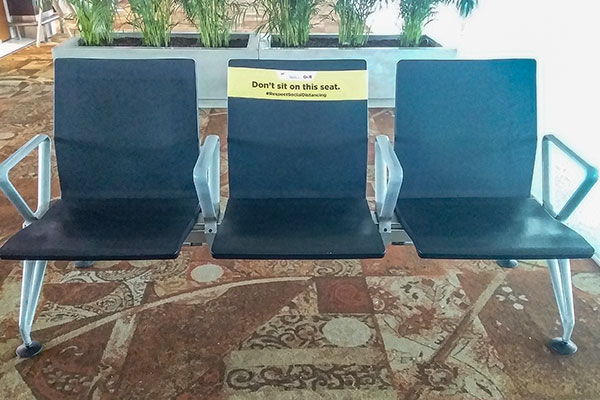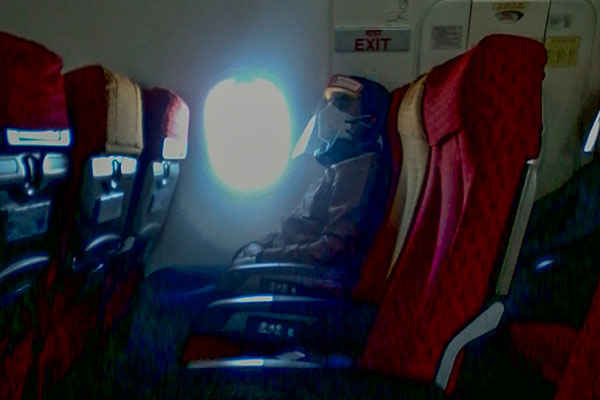Air travel during COVID-19

In retrospect, I feel like the proverbial rat abandoning a ship before it sinks. When I left Leh on 8 June, its COVID-19 tally was around 90-odd positive cases. By the time I reached Mumbai and the fog of reverse altitude sickness started to lift, Ladakh’s toll had started pumping steroids as it zoomed past 500 in the span of a few days. Unfortunately, I am not sure if my transition from Ladakh to Mumbai marked a move to safety or a jump from the frying pan into the fire.
My journey entailed a flight from Leh to Delhi, a five-hour wait and then another flight from Delhi to Mumbai. I chose Air India for this journey as it has a liberal baggage allowance and, in my experience, seems less likely to cancel flights when there are too few passengers.
I reached Leh airport two hours before the flight. The new systems at the airport were fairly well-organised. Perhaps, it helps that the passenger traffic at the airport remains low. I managed to enter the terminal building within seven minutes of reaching the airport. The bags were duly sanitised and I was asked the one question I had been dreading. In my head, the words “Aarogya Setu?” evoked images of our hon’ble Prime Minister and his cronies evangelising a phone app as a panacea for all evils. I nervously showed the staff members my Rs 1,400-phone and the person nonchalantly directed me to a window where I had to register my details.
So far so good. I will admit that it helped to speak a semblance of Ladakhi as the staff seemed far more courteous and helpful in Ladakhi. It may have been my imagination but the same people seemed a little more impatient in the Hindi and English that they were using with my co-passengers. I was also struck by the fact that most of my co-passengers were males. Of the 40 to 50 passengers on my flight, there were three women: Two were family members of an army officer, while the third was a Ladakhi girl.
It took me a while to get used to the lack of human contact and technological innovations at the airport. I have mastered the art of looking innocent when I hand my boarding pass/ticket and identity proof to the policeperson on duty. They generally respond by casting a look of deep suspicion in my direction. Instead of this modern-day ritual, I had to hold the paperwork in front of an impersonal camera, while the policeperson peered into a computer console behind a glass barrier. I detected no expression on his face as I held my papers up and then behaved like a convicted criminal by removing my mask and peering amiably into the camera—I was disappointed when I was not asked to show my profile to the camera. I missed that look of deep suspicion as I was simply waved inside by two police personnel maintaining a liberal dose of social distance from me.
I tried hard to assume my look of innocence once again for the benefit of the baggage screening staff. One of them was kind enough to accuse me of carrying a multipurpose tool in my cabin bag. I hardly own any tool but still jogged my mind to remember if I had one by accident. My GPS handset was the only possible explanation. I showed the friendly staff the handset and confessed that I have never owned the kind of tool she accused me of having in my bag. She remained disconcertingly warm, smiled and waved me through. I must admit that I was starting to miss that gaze of suspicion I associate with airports and security personnel. That said, I was warming up to this new-found sense of dystopia.
Once inside, I was fascinated to see everyone follow social distancing at the airport. Except one off-duty soldier who wanted to carry all the goodies he had bought from the canteen in his luggage. He managed to get into arguments with airline staff and policemen at the airport as each of them objected to different aspects of his aspirations. Overall, check in and security clearance was fairly straight-forward once you grew accustomed to conversing with cameras and holding up your paperwork for these infernal appliances. At the security check, I missed chatting with the person on duty. These conversations are generally interesting and enlightening. Instead, the policeman took a practiced step back like he was about to launch an attack. He then used the extra-long handle of his metal detector to do an aural check around my body and waved me through. The airport staff in Leh did a good job of avoiding human contact and the lack of crowds ensured that processes were smooth.
Once inside, I realised that I had not received the visor that many of my co-passengers were already wearing. I probably missed this part of the process when I took a slight detour to meet friends at the airport before moving towards the security screening.Anyway, the airline staff had accounted for clueless passengers like me and they duly ensured that I received a pack with a visor, a mask, a hand-sanitiser, and gloves. In return, I was asked to fill a health form confirming I was not suffering any symptoms, had never tested positive for COVID-19 and would not blame the airline for any risk that air travel posed to my health. I duly handed the form over to the staff who asked me to wear the visor as I was about to board the bus to the aircraft. I had mixed feelings about this. The visor made me feel like I was going into war or was about to be kicked into outer space. There was a blue plastic film on the visor that blurred my vision and I also started feeling like a hostage being led to a secret hideout.
The airline had ensured that seats were left empty between passengers to maintain social distancing. I was still struggling with the visor as it was stuffy and inspired me to think of health conditions such as claustrophobia and heat-stroke as I could barely see anything around me. Anyway, the flight departed 20 minutes before time and reached New Delhi in the hour that this flight generally takes. Am not sure why they had allotted an hour and forty minutes for the flight, except perhaps to shift the flight into a different fare category as the government had issued a time-based cap for flight fares.

Delhi was a different world altogether. I suddenly appreciated the visor-induced blurriness of my vision. I had the freedom of imagining Delhi without bothering with the reality around me. As I waited in the security check in the domestic transfer section, I was pleasantly surprised with the space that people were affording each other. I also noticed that many people were wearing white or blue kurtas. Finally, the heat got to me and I removed the visor. This was when I realised that the ‘kurta’ was not what it seemed. On closer scrutiny, it turned out that all these people were wearing Personal Protection Equipment (PPE).
Somewhat alarmed, I messaged a close friend who is a health professional to check if this was a necessity that I had neglected. He responded with an evolving response that went from denial, shock, alarm, weariness and finally, humour. He first accused me of joking. Then he refused to believe me. I sent him photographs to prove I was not joking or delusional. He stated that the people were wasting PPE and depriving health professionals of it. He explained that a mask should suffice for protection during a flight and that “the visor adds 7% more protection.” Finally, he started joking that I was in safe hands as there were so many ‘healthcare workers’ at the airport.
Despite enjoying the air of dystopia, I was fascinated to see how people negotiated their sense of normalcy. This included people who seemed to have taken the Prime Minister’s oft-repeated term of “Corona Warriors” to heart and turned out in their body armour (read PPE), while others treated the mask and visor with careless contempt or fashion accessories.
The number of people at Delhi airport was much higher than Leh but much less than what one generally encounters and expects there. Also, the airport staff was making an effort to implement safety measures, things were better organised than otherwise. The airports and airlines seemed to be making more efficient use of available space and time though flying at less than half capacity may not necessarily be the most efficient use of fuel.
Furthermore, old habits die hard. I saw many instances of people forgetting social distancing and the importance of wearing a mask when they felt they were ‘competing’ for a better deal in the form of a seat, larger space for their hand luggage or the fastest route out of the aircraft. All of us had to fill the omnipresent health form before we were allowed to board the aircraft.
The flight to Mumbai was delayed by three hours due to ‘technical reasons’ that the airline and its staff neglected to share with us passengers. So, we all sat inside the aircraft without air-conditioning and soaking in sweat under the mask and visor. After all that drama, we managed a fairly uneventful flight to Mumbai. Most people still rushed for the exit door as soon as the flight landed as though there was a prize for the first person to leave the aircraft. The airline staff tried to get some order in this madness but gave up after a point. Once outside the aircraft, everyone was asked to fill a health form that asked the same question as forms I had filled in Delhi and Leh earlier in the day. In each case, I was asked if I had symptoms or had tested positive and that I was releasing the airline from any liability for health risks I faced during the flight. After a point it seemed like bureaucracies simply enjoy creating work that has no consequence. I am not sure if anyone even bothers to read these forms.
The medical staff at Mumbai airport looked weary and exhausted. They gave the distinct impression that everyone has resigned the future to its fate. I finally reached home, exhausted and tired, around 2230 hours and quietly lapsed into home quarantine despite receiving no instruction from the medical staff at the airport. My left hand was stamped with some information that was illegible as it smudged immediately. The stamp survived two baths and disappeared altogether in three days.
Photographs and text by Sunetro Ghosal
Sunetro Ghosal is a part of the editorial team at Stawa

I like the ‘stamp on the hand’ ordeal. Nice read anyways…
Od juley Angmo ley